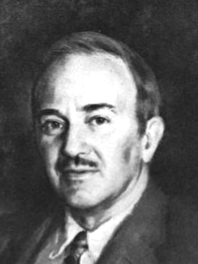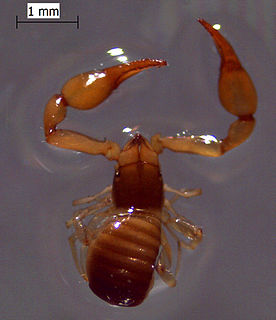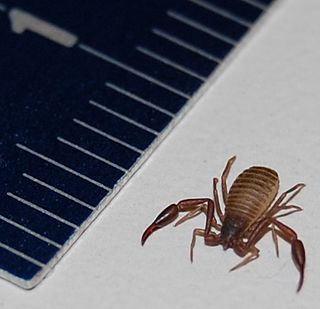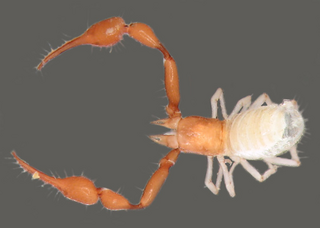
A pseudoscorpion, also known as a false scorpion or book scorpion, is an arachnid belonging to the order Pseudoscorpiones, also known as Pseudoscorpionida or Chelonethida.

Edward Hastings Chamberlin was an American economist. He was born in La Conner, Washington, and died in Cambridge, Massachusetts.
Marie M. Muchmore was one of the witnesses to the assassination of United States President John F. Kennedy in Dallas, Texas, on November 22, 1963. A color 8 mm film that Muchmore made is one of the primary documents of the assassination. The Muchmore film, with other 8 mm films taken by Abraham Zapruder and Orville Nix, was used by the Warren Commission to investigate the assassination and to position the presidential limousine in a forensic recreation of the event in May 1964.
Tridenchthoniidae is a family of pseudoscorpions within the superfamily Chthonioidea. The family comprises one fossil and 15 recent genera, containing 70 species:

The Pseudogarypidae are a small family of pseudoscorpions. Most recent species are found in North America, while one species is endemic to Tasmania.

Joseph Conrad Chamberlin was an American arachnologist who studied mainly pseudoscorpions. A native of Utah, he studied primarily at Stanford University while working most of his career in Oregon for the U.S. Department of Agriculture. Several species are named in his honor.
The Menthidae are a small family of pseudoscorpions that are nevertheless spread around the world. While Menthus is found from Mexico to California, Oligomenthus lives in South America. The monotypic genera Paramenthus and Thenmus live in Israel and Australia, respectively.

Chthoniidae is a family of pseudoscorpions within the superfamily Chthonioidea. The family contains more than 600 species in about 30 genera. Three fossil species are known from Baltic and Dominican amber.

The Chernetidae are a family of pseudoscorpions with over 650 described species and 110 genera.
Olpiidae is a family of pseudoscorpions in the superfamily Garypoidea. It contains the following genera:
Atemnidae is a family of pseudoscorpions.
Dinocheirus is a genus of pseudoscorpions in the family Chernetidae.

Hololena is a genus of North American funnel weavers first described by R. V. Chamberlin & Willis J. Gertsch in 1929.
Garypus is a genus of pseudoscorpions in the family Garypidae. There are at least 20 described species in Garypus.

Cheliferidae is a family of pseudoscorpions in the order Pseudoscorpiones. There are at least 60 genera and 270 described species in Cheliferidae.

Syarinidae is a family of pseudoscorpions in the order Pseudoscorpiones. There are at least 20 genera and 110 described species in Syarinidae.
Syarinus is a genus of pseudoscorpions in the family Syarinidae. There are about six described species in Syarinus.
Hesperochernes is a genus of pseudoscorpions in the family of Chernetidae.
Chitrella is a genus of pseudoscorpions in the family of Syarinidae.








